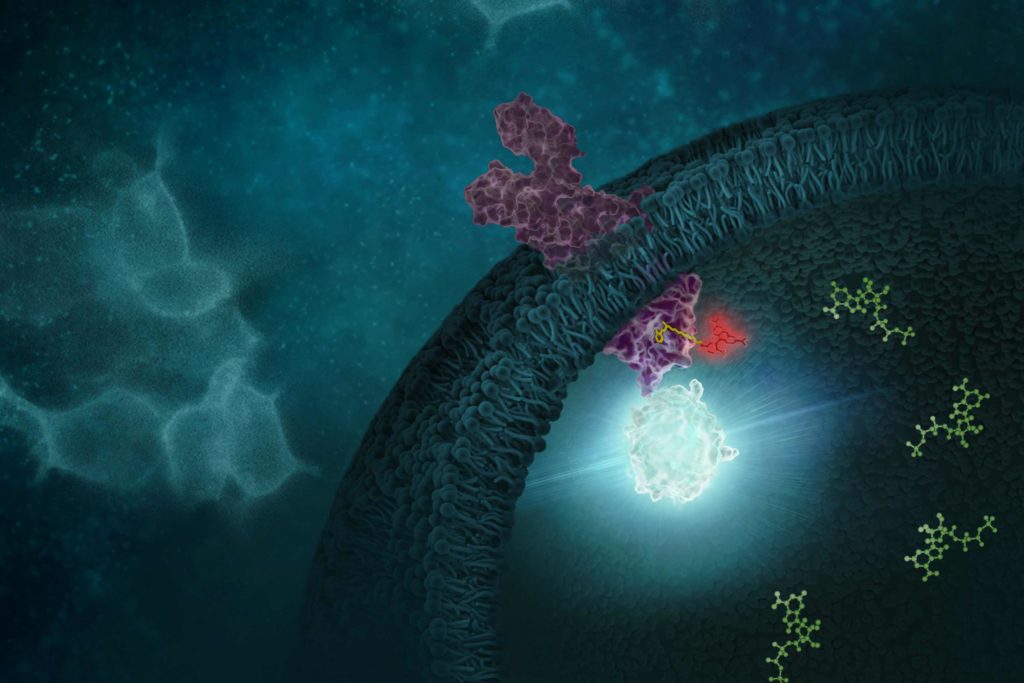
A new study published in Nature Chemical Biology shows that the most commonly mutated protein in cancer might not be as “undruggable” as previously believed. Promega R&D scientists collaborated with the research group led by Kevan Shokat at the University of California – San Francisco to develop strategies for targeting mutants of KRAS that have evaded previous drug discovery efforts. Their paper opens new possibilities for developing small molecule inhibitors against KRAS(G12D) and other clinically significant mutants.
KRAS Mutations in Cancer
KRAS is a small GTPase that acts as a master switch for cell proliferation. When an activating mutation leaves that switch in the “on” position, cells can grow and divide uncontrollably. Previous research has found that at least 15% of all human cancers involve an activating KRAS mutation.
Unfortunately, KRAS is notoriously difficult to target with small molecule drugs. The protein has a globular shape without obvious features for drug binding, so for many years it was considered fully “undruggable.” In 2013, the Shokat Lab changed that paradigm by demonstrating that KRAS(G12C), a mutant in which a glycine amino acid is replaced with a cysteine, was susceptible to non-covalent inhibitors. These molecules bind to a region called the switch-II pocket (SII-P). Suddenly, KRAS(G12C) was druggable, and several inhibitors targeting this mutant have since been developed. The FDA granted approval to sotorasib, the first KRAS inhibitor, in May 2021.
Still, the strategies used against KRAS(G12C) could not be generalized to other mutants. As a GTPase, KRAS displays slight conformational changes when active in a GTP-bound state versus the inactive GDP-bound state. KRAS(G12C) retains the active/inactive cycling shown by the wildtype protein, and its inhibitors depend on binding to the inactive GDP state. Other clinically significant mutants, such as KRAS(G12D) and KRAS(G12V), spend almost all of their time in the active GTP state. KRAS(G12D) and KRAS(G12V) are the two most common KRAS mutants, and drugs targeting these mutants would need to bind to the GTP-bound state of KRAS.
Targeting Active GTP-state KRAS Alleles
The new study in Nature Chemical Biology demonstrates that noncovalent ligands can access the SII-Ps of many hotspot KRAS mutants. This binding is not dependent on the GDP-state of the protein, and it results in a decrease in cell proliferation.
The team used nuclear magnetic resonance (NMR) spectroscopy to evaluate the binding of a collection of ligands to wild-type KRAS, as well as KRAS(G12C) and KRAS(G12D). They found that ligands previously shown to covalently bind to KRAS(G12C) showed non-covalent affinity to wild-type KRAS and KRAS(G12D) in their inactive states, but not in their active GTP-bound states. They also analyzed compounds developed by Mirati Therapeutics known to inhibit KRAS(G12D) and found that these showed non-covalent affinity for both the GDP- and GTP-bound states of wild-type KRAS and KRAS(G12D).
Next, the researchers used a NanoBRET Target Engagement Assay to quantify KRAS target engagement in vivo. The assay uses bioluminescence resonance energy transfer (BRET) to quantitatively measure target occupancy, compound affinity, residence time and permeability in live cells. The target protein is expressed as a NanoLuc® luciferase fusion. A cell-permeable fluorescent tracer is then added to the sample, which reversibly binds the target protein. When the tracer is in close proximity to NanoLuc® luciferase, it generates a BRET signal that can be measured on the GloMax® Discover Microplate Reader. If a test compound competes with the tracer, the signal is lost. The assay is based in live cells, producing results that more closely mimic how a compound will behave in the human body.
The NanoBRET Target Engagement Assay showed that MRTX-EX185 was highly potent against KRAS(G12D), as well as several other clinically significant mutants. Further analysis with CellTiter-Glo 2.0 showed that this binding produced an antiproliferative effect. While the molecule engaged the SII-P in a similar orientation as known KRAS(G12C) inhibitors, this binding was not dependent on covalent binding to the thiol of the cysteine residue, nor was it dependent on the inactive GDP-bound state.
Conclusions
As two correspondents acknowledge in a commentary published in Nature Chemical Biology, these results indicate that KRAS is no longer undruggable, as it has been considered for decades. The methods demonstrated in the new paper provide a complete workflow for profiling direct target engagement of KRAS inhibitors during small molecule drug discovery. The authors hope that their work will support future work to develop treatments for cancers that involve mutations to KRAS.
Learn more about using NanoBRET™ Target Engagement technology to measure target affinity and occupancy across multiple RAS variants.
